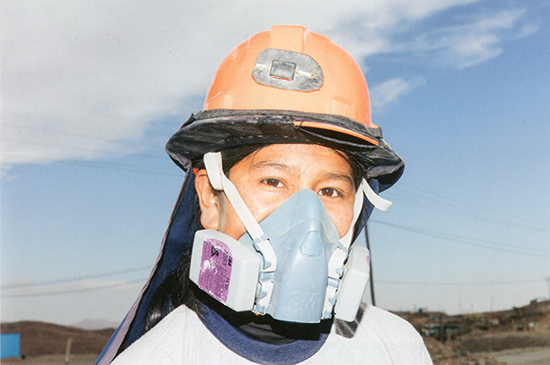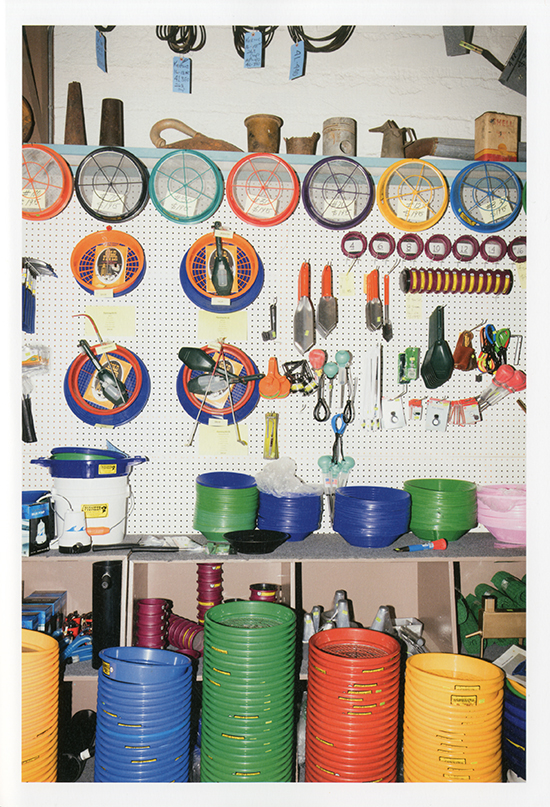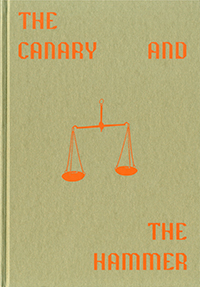| SIMON DENISON IMAGE & TEXT |
| PREVIOUS | NEXT |
THE CANARY AND THE HAMMER Lisa Barnard MACK, 2019 ISBN 978-1-912339-33-4 Hb
Conceived as a response to the 2008 financial crisis, The Canary and the Hammer is a research-led photographic study of gold, that enduring symbol of wealth and legendary object of human greed. Like the canary in a coal mine, Barnard writes, gold is a ‘gauge’ of our economic stability, while ‘the hammer is the tool that smashes the structures in which it is embedded’. As is evident from the idea of smashing, the book takes an explicitly anti-capitalist line, focusing largely on production and what Barnard sees as the damaging exploitation of resources and labour, especially female labour, that is involved in the production process. In doing so she is pursuing what she appears to regard as photography’s mission: in thinking about the medium, she asserts, what is most important is ‘to address photography’s ability to attend to capitalism and labour’. The book roves widely around the global gold industry, making observations on a Fairtrade mining organisation in Peru; the historical European colonial quest for gold in the Americas, linked with current US space exploration programmes; the community of low-status hobby gold miners in present-day California; the toxic e-waste recycling industry in China and elsewhere, linked with jewellery manufacture in Birmingham; uses of gold in high-tech engineering, scientific and medical applications; and a slightly anomalous, if interesting, chapter on a secret operation to ship UK gold bullion to Canada for safekeeping in the early years of World War II. The book claims not to be a comprehensive study, and it follows a particular direction of interest; but some omissions are nonetheless striking. There is little here on the fetishising uses of gold as a body and dress adornment or material for high-status display; or on the different connotations of gold for different socio-cultural groups. The book also skips lightly around the very root of the issue: the ancient and persistent fascination that so many societies – not just conquistadors and colonialists – have had for gold, across continents and cultures from the beginnings of metallurgy to the present day; an unavoidable, and in many ways puzzling, historical fact that is fundamental to all that follows in terms of prospecting, mining, manufacture and exchange. Even so, much of what Barnard has discovered in this extensively researched, 10-year project is intriguing: nuggets of particular interest (to me) include the widespread use of gold in space exploration, including in a gold-plated camera and tripod taken to the surface of the moon by Apollo 16 astronauts in 1972; the ubiquitous but hidden presence of gold in everyday household electronics such as mobile phones, computers, televisions and cameras; medical uses of gold nanoparticles for the eradication of tumours and the detection of heart and other diseases; and the use of plants to clean up mine waste by drawing residual gold up through their roots to store it in their leaves. These are, I would suggest, all largely positive features of the way gold is currently used and processed by industry and science and they sit somewhat at odds with the book’s pervasive negative rhetoric about capitalism’s destructive and self-destructive tendencies. The images in the book vary widely. A few documentary-style images and naturally lit outdoor portraits, and a handful of historical images and computer graphics, sit alongside a majority of harshly lit close-ups of raw materials, industrial equipment and machinery, scientific apparatus, shop displays, and people (mostly young women) in their working environments. The flash lighting erases all sense of environmental and social context, isolating people and objects in staged, artificial-looking set-ups as if presenting them as police exhibits in a court case. Barnard’s captioning strategy is unconventional. Some images are captioned on the page, some at the back of the book, but most are not captioned at all, leaving the reader to guess at what exactly we are being shown. This ambiguous approach to visual communication produces mainly vague impressions of an industry that is sometimes dirty, messy and low-tech, sometimes sterile and high-tech, but which always seems to offer an unappealing way to earn a meagre living. When captions are given they are sometimes short on detail: for example, a complex graphic resembling a mountain range is described as a 3D representation of the price of gold since the 13th century, but no indices are given so it is impossible to read. The ultimate in bafflement comes from a set of five images of soldiers, possibly British, running down a grassy slope past three leafless trees, with one of the images printed twice (why?): the set is uncaptioned, and unconnected, as far as I can tell, to any subject matter in the book. The book’s design is energetic, slightly hyperactive, with a constant variety of picture sizes and arrangements, bleeds and margins, monochrome and colour. Double-page images at the start of each chapter are split by interleaved sections of text. The overall effect of images, captioning and layout is unsettling and alienating. There is little that calls the reader to linger. Whether this is an intentional ploy, as advocated by Adorno, to destabilise the audience in order to bring about a change of consciousness, is hard to say. The project was exhibited at Format Festival in 2017 as an interactive, multi-sensory display (see Source 90). Published in book form, its strengths and shortcomings present themselves more readily for scrutiny. Research-led photographic projects are inevitably judged for their text as much as their imagery, and the writing here is very uneven, littered with typos, spelling mistakes and other errors: one wonders if the publishers even read it. But as an example of serious, investigative photographic practice the book is engaging and serves as a model, or perhaps a point of departure, for future work. |
 |
|---|---|
 |
|
 |
|